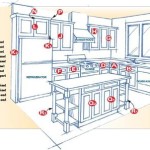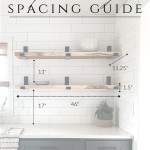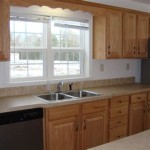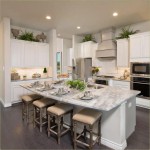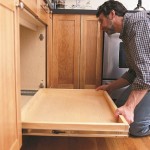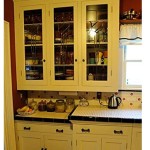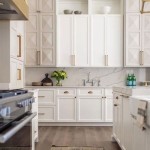Where to Place Knobs on Kitchen Cabinet Doors: A Comprehensive Guide
The placement of knobs on kitchen cabinet doors is a seemingly minor detail that significantly impacts both the aesthetics and functionality of a kitchen. Correct placement enhances visual appeal, ensures comfortable use, and contributes to the overall ergonomic design of the space. Conversely, improper placement can lead to an awkward or unbalanced look, inconvenience in opening and closing cabinets, and potential damage to the cabinet doors themselves. Therefore, a thoughtful approach to knob placement is essential in achieving a well-designed and user-friendly kitchen.
This article offers a comprehensive guide to determining the optimal placement for knobs on various types of kitchen cabinet doors, considering factors such as cabinet style, size, and the desired aesthetic. We will explore common practices, provide specific measurements, and discuss variations to accommodate different design preferences and functional requirements.
Understanding the Basics of Knob Placement
Before delving into specific measurements, it's crucial to understand the foundational principles that guide knob placement. Uniformity and visual balance are key considerations. Consistency in knob placement across all similar cabinet doors creates a cohesive and professional appearance. However, the optimal location is also influenced by the cabinet's construction and the intended use.
For standard base cabinets, the most common placement is along the stile, the vertical frame component of the cabinet door. This provides adequate leverage for opening the door and aligns with the natural hand position. For wall cabinets, the same principle applies, although the specific measurement from the top or bottom edge may differ.
The size and style of the knob itself also play a role. Larger or more decorative knobs may require slightly adjusted placement to avoid looking disproportionate or interfering with adjacent cabinets or countertops. Similarly, the thickness of the cabinet door should be considered, as some knobs may require longer screws to ensure secure attachment.
Specific Guidelines for Different Cabinet Types
The optimal placement of knobs varies depending on the type of cabinet door. Here are detailed guidelines for common kitchen cabinet configurations:
- Standard Base Cabinets: For standard base cabinets with framed doors, a typical placement is 2 to 3 inches from the top corner of the door along the stile. This measurement is usually consistent for both left- and right-hinged doors. This placement puts the knob within easy reach and minimizes strain when opening the cabinet. For frameless cabinets, the same measurement applies, positioning the knob on the vertical edge of the door panel.
- Standard Wall Cabinets: For standard wall cabinets, the knob is generally placed 2 to 3 inches from the bottom corner of the door along the stile. This mirrors the placement for base cabinets, creating a visual harmony. Again, this measurement is typically the same for both left- and right-hinged doors. Positioning the knob lower on wall cabinets provides a more comfortable grip, especially for taller cabinets.
- Drawers: While this article primarily focuses on cabinet doors, it's important to briefly address drawer knob placement for overall consistency. For drawers, knobs are typically centered, both horizontally and vertically, on the drawer face. The specific height will depend on the drawer's dimensions, but the goal is to create a balanced and symmetrical appearance. For very wide drawers, two knobs may be used, placed symmetrically on either side of the center line.
- Pantry Cabinets (Full Height): For tall pantry cabinets, knob placement often depends on the style and construction of the door. If the door has a traditional framed design, the knob can be placed 2 to 3 inches from the bottom corner, similar to wall cabinets. However, for slab doors or modern designs, the knob may be placed at a more ergonomic height, typically around 36 to 40 inches from the floor. This ensures comfortable access without requiring excessive bending or reaching.
- Corner Cabinets: Corner cabinets often present unique challenges due to their angled design. For blind corner cabinets (those with a portion that extends into the adjacent cabinet), the knob should be placed on the visible portion of the door, following the same guidelines as standard base cabinets. For Lazy Susan cabinets (those with a rotating shelf inside), the knob placement should consider the swing of the door and ensure it doesn't obstruct the rotation of the Lazy Susan mechanism.
These measurements are intended as general guidelines. Minor adjustments may be necessary based on individual preferences and the specific characteristics of the cabinets.
Advanced Considerations for Knob Placement
Beyond the basic guidelines, several advanced considerations can further refine knob placement and enhance the overall kitchen design.
- Visual Balance: The overall visual balance of the kitchen should be considered when determining knob placement. If the kitchen features a mix of cabinet sizes and styles, it may be necessary to adjust the placement slightly to create a more harmonious appearance. For example, if some cabinets have significantly larger doors, the knob might be positioned slightly lower or higher to compensate for the increased size.
- Ergonomics: Ergonomic considerations are paramount in ensuring a comfortable and user-friendly kitchen. The placement of knobs should allow for easy and natural hand positioning, minimizing strain on the wrists and arms. Consider the height of the primary user and adjust the knob placement accordingly. Mock up the placement by temporarily attaching the knob and physically testing the opening and closing of the cabinet door.
- Cabinet Construction: The construction of the cabinet door can also influence knob placement. For doors with intricate molding or raised panels, it may be necessary to adjust the placement to avoid interfering with these decorative elements. Ensure the knob is securely attached to a solid portion of the door and that the screws do not protrude through the back of the door.
- Hardware Style and Size: The style and size of the knob itself can impact the optimal placement. Larger or more ornate knobs may require slightly adjusted positioning to avoid looking disproportionate. Consider the overall aesthetic of the kitchen and choose knobs that complement the cabinet style and finish. A cohesive hardware selection contributes significantly to the overall design.
- Using Templates: Utilizing templates for knob placement can ensure consistency and accuracy across all cabinet doors. Templates can be created from cardboard or purchased from hardware stores. These templates provide a precise guide for drilling the holes for the knobs, minimizing errors and saving time.
These advanced considerations contribute to a more refined and personalized approach to knob placement, resulting in a kitchen that is both aesthetically pleasing and functionally efficient.
In addition to these points, it is important to consider the practical aspect of using the cabinets. For example, in a kitchen frequented by children, knobs on lower cabinets might be placed slightly higher to discourage them from opening the cabinets unattended. Or, for individuals with limited mobility, lower placement might be preferred for easier access. These user-specific modifications underscore the importance of considering the individual needs of the household when finalizing hardware placement.
The selection of a knob's materials also plays a subtle but important role. Knobs made from heavier materials like metal may necessitate slightly more robust installation, ensuring that the cabinet door can withstand the added weight and repeated use. Conversely, lighter materials like plastic or wood might allow for a more streamlined installation process. Always review the manufacturer’s instructions for the specific hardware selected.
Furthermore, the choice between knobs and pulls should also be a deliberate decision. While this article focuses on knob placement, pulls offer an alternative hardware option that may better suit certain kitchen styles or provide enhanced grip. Pulls are generally preferred for larger or heavier cabinet doors or drawers, as they distribute the force of opening and closing more evenly. When considering pulls, the same principles of ergonomics and visual balance should guide their placement.
Finally, it is always advisable to consult with a professional kitchen designer or installer when undertaking a kitchen renovation project. These professionals possess extensive experience in cabinet hardware placement and can offer valuable insights based on the specific layout, design, and functional requirements of the kitchen. Their expertise can help avoid costly mistakes and ensure that the final result is both beautiful and practical. They can also provide guidance on selecting the appropriate hardware styles and finishes to complement the overall kitchen aesthetic.

A Simple Guide For Cabinet Knob Placement Julie Blanner

How To Place Cabinet Knobs Pulls

How To Place Cabinet Knobs Pulls

Learn How To Place Kitchen Cabinet Knobs And Pulls Cliqstudios

A Simple Guide For Cabinet Knob Placement Julie Blanner

Design 101 Cabinet Hardware Placement Lark Linen

How To Place Cabinet Knobs Pulls

Where To Place Cabinet Hardware Emtek

Hardware Placement

Learn How To Place Kitchen Cabinet Knobs And Pulls Cliqstudios
Related Posts

